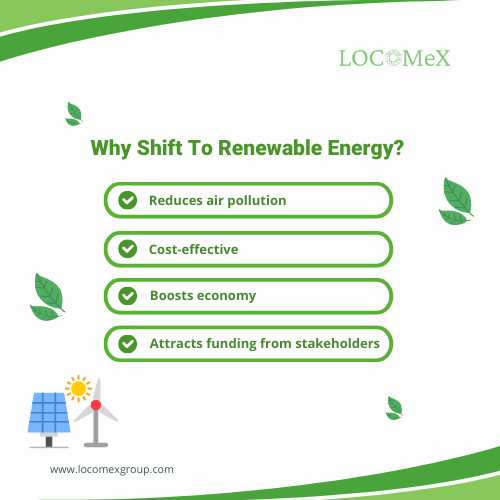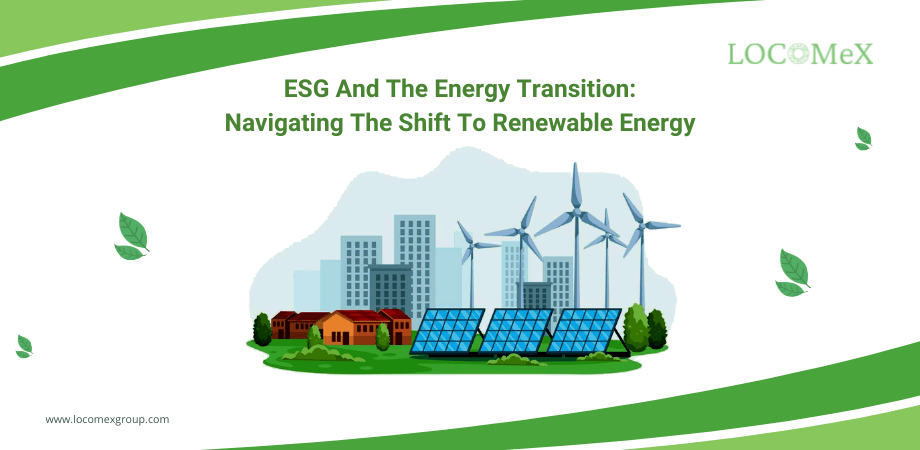ESG, in abbreviated form, is Environmental, Social, and Governance. ESG refers to the set of standards implemented by socially responsible organizations, and it checks and reports the ethical impacts of investment on the environment, social, and governance bodies. The global energy transition is a part of the environmental factor of ESG. Moreso, it is imperative to meet international climatic goals.
Why Shift To Renewable Energy?
The global transition from fossil fuels-based sources to renewable sources has become significant as renewable energy costs fall. Fossil-based sources are oil, natural gas, coal, and alike. And renewable sources are wind, solar, and lithium-ion batteries. The main reasons why the world has to transition to renewable energy production are as follows:
- It is incumbent on the global energy sector to shift to renewable resources if they want to improve energy access, supply, and consumption.
- Global energy consumption and demands have increased, and energy transition is mandatory.
- Renewable sources are cost-effective. The costs of renewable sources are declining rapidly.
- Vouching for a healthy ecosystem is what today’s world needs by reducing pollution.
- A spike in employment rates is expected due to the energy transition, boosting economic growth.
While energy transition can be a boon to the world economy, risks like changes in regulations and policies are involved. They might impact the agricultural sector and carbon-heavy industries, and low-carbon technologies can prove to be highly expensive in costs.
At LOCOMeX, we facilitate both supplier-based and project-based ESG risk-scoring tools. Our Best Project-Based ESG risk Scoring Tool provides investment-grade and auditable ESG and Scope 3 emission data for better decision-making.
The Role Of ESG In Energy Transition
With global warming leading to intense heat waves, reducing sea levels, shrinking ice sheets, etc., and the world facing a climate crisis, an energy transition with ESG is the need for a sustainable global economy. The above are the effects of carbon and methane emissions into the atmosphere, and a way to reduce emissions is to monitor them through sustainability reporting.
ESG metrics give an overview of carbon emissions and help businesses manage their emissions through ESG reports. Nowadays, energy companies focus on green energy, net zero emissions, and a low-carbon future. Progress in renewable power generation is a vital step toward climate action. Let us have an overview of how the oil and gas sector affects the environment and how ESG can help curb the environmental crisis.
Energy Transition Impact On Oil And Gas Companies
Energy transition will have a profound impact on the world in the transition pathway in the coming decades. It is not a shift that the world will see immediately but a gradual process to adapt to the new energy system providing essential energy services. Oil and gas companies have already committed to reducing carbon, nitrous oxide, and methane emissions and are progressing in renewable resources. The International Renewable Energy Agency is addressing the need for renewable energy in industrialized nations and developing nations.
a) Pollution Impacts: Pollution impacts of oil and gas production are the main concerns of oil and gas companies as emissions intensity is creating climate change. ESG is relevant to the oil and gas sector because it helps regulate environmental issues and provides a sustainable business model. ESG analysis and implementation improve the investments and ultimately result in cash flows for the portfolio companies. And that’s why traditional oil companies are moving to more sustainable energy sources than fossil fuels.
b) Carbon Prices: Carbon pricing effectively encourages companies to reduce coal, oil, and gas combustion emissions. The carbon price is the cost applied to the carbon emitted by the gas company. Oil and gas companies have been a great source of revenue for oil-producing countries. The oil and gas industry faces transition risks as they contribute to the returns of investments and boost the financial markets. Your ESG strategic planning must include setting the internal carbon prices.
LOCOMeX’s Best Project-Based ESG Risk Scoring Tool gives accurate metrics of your emissions risk data opening the best pathway for your energy transition. It will also standardize your organization’s values and help you perform better.
c) Global Capital Investment: Capital allocation in the oil and gas sector was reduced in 2020 and 2021 due to the Covid-19 pandemic. Also, companies invest in low-carbon technologies instead of industries that emit high carbon and produce fossil fuels. Plummeting oil prices have also been the reason for shifting consumer preferences.
ESG funding has grown over the past few years as the vast majority of the stakeholders are challenging the ESG credentials of the companies. ESG approach can help scale supply chains, create markets, and attract funding. The Best Project-Based ESG Risk Scoring Tool will provide accurate reporting, data, and risk scores within your supply and value chain at the project level.
International energy agency is making immense progress towards procuring data on energy transitions and contributing to a sustainable energy future. Just transition occurs when world leaders accept the need for green technologies and invest in them.

An ESG Business Model For Curbing Greenhouse Gas Emissions
Methane (CH4), Carbon dioxide (CO2), Nitrous Oxide (N2O), and Ozone (O3) are some of the harmful gases released into the atmosphere primarily by burning fossil fuels. These emissions are the results of the Industrial Revolution that started in the 1700s, and GHG emission is the main cause of the rise in global temperatures.
GHG emissions are divided into three categories Scope 1, Scope 2, and Scope 3. Scope 3 emissions are the hardest to tackle and measure as they are produced by customers using the company products. Scope 3 Emissions Management Software accurately measures and reports the emissions. A GHG Emission Management Software, in general, calculates and reports the emissions from all three scopes.
Climate change legislation has to be backed by fossil-fuel-producing countries to tackle this problem. The usage of renewable sources should be pushed further, and the energy transition must be made effortless. Every energy company should integrate ESG into its business model.
A good ESG performance generates investor interest in the company and improves corporate earnings. ESG frameworks facilitate organizations to make better decisions by understanding and identifying the risks involved in the energy transition.
LOCOMeX: Your Best ESG Metrics Solution Partner
Emerge as business leaders by employing our ESG techniques for a sustainable future. We are equipped with the Best Project-Based ESG Risk Scoring Tool that offers auditable investment-grade ESG & Scope 3 emission reporting data generated at the project level within the supply & value chains.
Our other tools include the Supplier-Based Sustainability Risk Scoring Tool and the Supplier-Based ESG Risk Scoring Tool. Our best ESG Benchmarking Tool gives accurate data and analysis for enterprises, prime vendors, and suppliers.
Reach out to our experts and utilize our ESG solutions to create synergy in your energy transition journey and become the natural owners.




